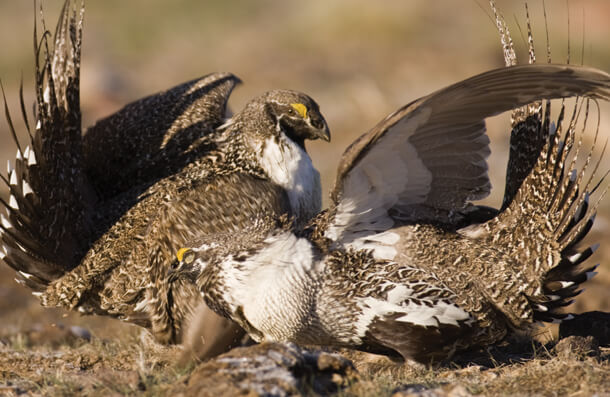Colorado Sage Grouse Conservation Plan Leaves Species at Risk of Endangerment
Robert Johns: 202-888-7472, Email click here

Greater Sage-Grouse, Noppadol Paothong
(Washington, D.C., June 30, 2015) To prevent the Greater Sage-Grouse from sliding toward endangerment, the Northwest Colorado Greater Sage-Grouse Final Environmental Impact Statement needs significant improvements to stop habitat loss, says American Bird Conservancy (ABC).
This assertion is part of a comment letter on the Colorado Plan ABC and Prairie Hills Audubon Society submitted Monday to the Bureau of Land Management (BLM). The letter makes science-based recommendations that can be adopted to better conserve the species. The letter states:
"…that while in many instances the Northwest Colorado plan marks progress over current management, it in some cases does not follow the management recommendations of scientists, leaves open the potential for further habitat loss or degradation, and does not designate protected reserves or focal areas for Greater Sage-Grouse. We urge that the FEIS be revised to prevent the construction of new transmission lines, oil and gas fields, and roads in priority sage grouse habitat."
The Final Environmental Impact Statement reveals that priority sage grouse habitat in the region is already heavily impacted by a variety of developments. For example, of the 926,700 acres of priority sage grouse habitat, a cumulative total of 857,400 acres already have already suffered, or are at significant risk of suffering harmful impacts.
These include 40 communications towers; 60 miles of utility corridors impacting 40,500 acres; 10,400 miles of transmission lines; rights-of-way covering 257,600 acres; 331,500 acres leased for oil and gas drilling; 2,100 miles of road impacting 21,000 acres; 19,400 acres of locatable mineral claims; mineral material disposal sites impacting 21,300 acres; grazing allotments that do not meet land health standards that cover 166,100 acres; and 1,500 miles of fences.
Further, oil and gas drilling is expected to expand to include another 1,889 well pads and 5,356 wells to be drilled in priority sage grouse habitat. In addition, the upcoming Oil Shale and Tar Sands Programmatic EIS could open additional priority habitat in Colorado to development.
Two transmission line projects, Gateway South and TransWest Express, are also being allowed to be built under the Colorado Plan. These projects have the potential to cause substantial loss of habitat for the grouse.
Because sage grouse avoid tall structures, they need to have at least a four-mile buffer from transmission lines. The effective habitat loss from these two projects could be immense: The TransWest Express project could impact approximately 3,584,000 acres, while the 400-mile-long Gateway South project could impact another 2,048,000 acres.
“Sage Grouse avoid tall structures like transmission lines and communications towers so new developments need to be located outside of their habitat,” says Steve Holmer of American Bird Conservancy. “The exemptions for the interstate transmission lines and weak buffer standards from other tall structures threatens to undermine the effectiveness of the Plan and could ultimately cause grouse to be extirpated from those habitats.”
#
American Bird Conservancy is the Western Hemisphere's bird conservation specialist—the only organization with a single and steadfast commitment to achieving conservation results for native birds and their habitats throughout the Americas. With a focus on efficiency and working in partnership, we take on the toughest problems facing birds today, innovating and building on sound science to halt extinctions, protect habitats, eliminate threats, and build capacity for bird conservation.


















































